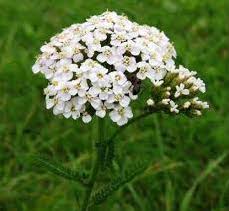Yarrow
I- Nomenclature
Latin Name :Achillea millefolium
Family:Asteraceae
Common Names
Common yarrow, gordaldo, nosebleed plant, old man's pepper, devil's nettle, sanguinary, milfoil, soldier's woundwort, thousand-leaf, and thousand-seal.
Etymology
From the Old English gearwe, (Old High German garawa, German garbe).
II- Legends and traditions
History
The plant’s medicinal reputation dates from as far back as prehistory according to archaeological finds at the Neanderthal caves of Shanidar in Iraq (c.60,000 BCE). One burial site contained pollen samples of plants with medicinal properties suggesting that Neanderthal man had developed a basic herbal pharmacopeia, which included yarrow.
The Greek hero Achilles in Homer’s Iliad is said to have used yarrow to heal his soldiers’ wounds in the Trojan wars, from which originates the plant’s Latin name Achillea millefolium. For centuries it has been carried in battle because of its magical as well as medicinal properties.
In the first century, the Greek physician Dioscorides first recorded the use of yarrow for staunching the flow of blood from wounds, as well as for the treatment of new and chronic ulcers.
The I Ching (Book of changes): traditionally, 50 dried yarrow stalks were used for consulting the oracle. The herb was said to promote inner emptiness, thus helping the seeker to focus on his question.
III- Botanical description
Description
A perennial, herbaceous plant that grows from 20cm to 60cm high. The stalks are straight, rigid, grooved and hairy.
The leaves are alternate, feather-like and sessile.
The flowers consist of flat-topped clusters with numerous small flower heads, white or pink in colour. The plant commonly flowers from May through to June.
The plant produces white, flat ovoid achenes (fruit).
Habitat
The plant is common in Europe, North Africa, North America and Asia.
Yarrow is found in sunny positions with well-drained soil. It is drought resistant and can be found in dry or poor soils, as well as in moist ones. It grows along the side of paths, roads and train lines, and is also found in meadows, gardens and on wasteland. It grows up to an altitude of 2,500m. Parts used
Aerial parts
Harvest
Whilst in flower
IV- Active ingredients
Active principles:
Flavonoids,
from 0.2 to 1% essential oil made up of mono and sesquiterpenes: azulene, cineole, camphor, chamazulene.
tannins,
salicylic acid,
coumarins.
V- Therapeutic uses
Properties
Flowering tops:
- antispasmodic
- antipyretic
- astringent
- relaxes the peripheral blood vessels
- emmenagogue
- bitter tonic
Essential oil:
- anti-inflammatory
- anti-allergenic
- antispasmodic
Uses
All catarrhal problems
Sluggish digestion, liver hypertrophy and insufficient bile secretion
Period pains
Circulatory system disorders, hemoptysis, haemorrhages
Haemorrhoids
Incontinence
Non-bleeding wounds
Therapeutic uses
Flowers:
Infusion: drink an infusion for all catarrhal problems linked to the upper respiratory system and for period pains. Apply externally for eczema (40g per litre).
Inhalation: for hay fever and mild asthma, use fresh flowers in boiling water.
Injection: of an infusion for vaginal discharges.
Wash: in cases of rectal bleeding.
Essential Oil:
Massage: for inflamed joints, rheumatism and neuralgia dilute 5-10 drops of essential oil in 25ml infused St John’s Wart oil.
Ointment: for chesty colds and influenza, combine with eucalyptus, peppermint, hyssop or thyme oil. Dilute up to 20 drops of essential oils in 25ml of almond or sunflower oil and the same quantity of wax (or lard).
Leaves:
Fresh: to stop nose bleeds, place a leaf in the nostril.
Poultice: use fresh, washed leaves to dress cuts and grazes.
Aerial parts:
Infusion: use to reduce fevers or improve digestion (40g per litre of water)
Tincture: use for urinary disorders or menstrual problems: 1 tablespoon/day. Under medical supervision, used for heart conditions.
Compress: soak a pad in the infusion or dilute tincture to soothe varicose veins
COUNTER INDICATIONS
Avoid large doses in pregnancy as the herb is a uterine stimulant.
In rare cases yarrow can cause severe allergic skin rashes; prolonged use can increase the skin’s photosensitivity
INTERACTIONS
When taken with horsetail, pre-menopausal women may experience a recrudescence of hot flushes. These disappear when they stop taking horsetail.
WARNING
Some constituents of the essential oil are neurotoxic and can induce abortions. Do not use internally unless under the supervision of a qualified aromatherapist.
Other uses
Yarrow was commonly used as a vegetable in the seventeenth century. The younger leaves can be cooked like spinach or used in soups.
Yarrow can help combat soil erosion due to the plant's resistance to drought. The plant can, however, become invasive.
Yarrow has insect repelling qualities and also attracts helpful insects such as predatory wasps and ladybugs to help control pests.
Yarrow is an excellent natural fertilizer. Add a handful of yarrow leaves to your compost to add nutrients and to speed up the composting process.
Due to the high mineral content of the leaves, yarrow was used to help prevent mineral deficiencies in cattle and sheep.


